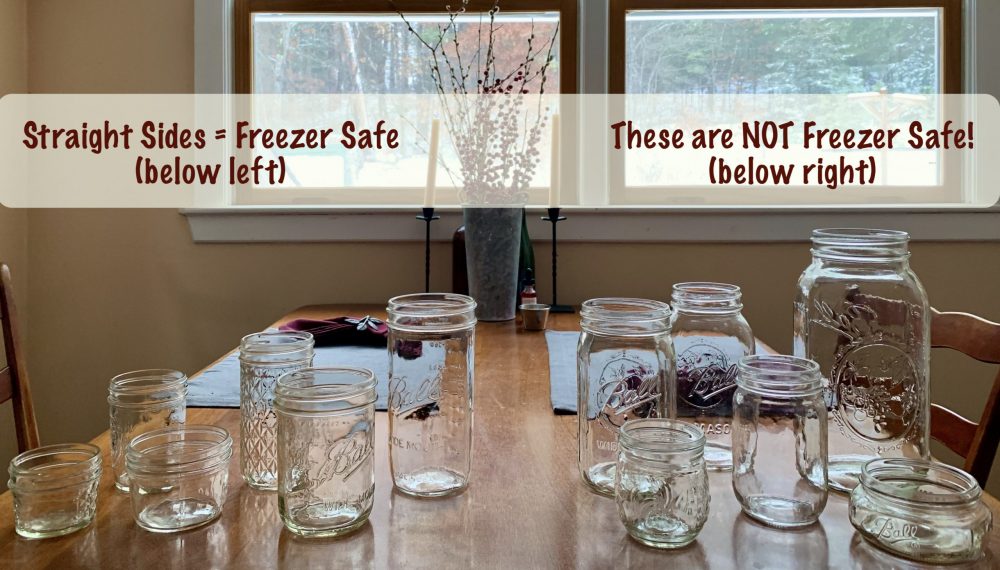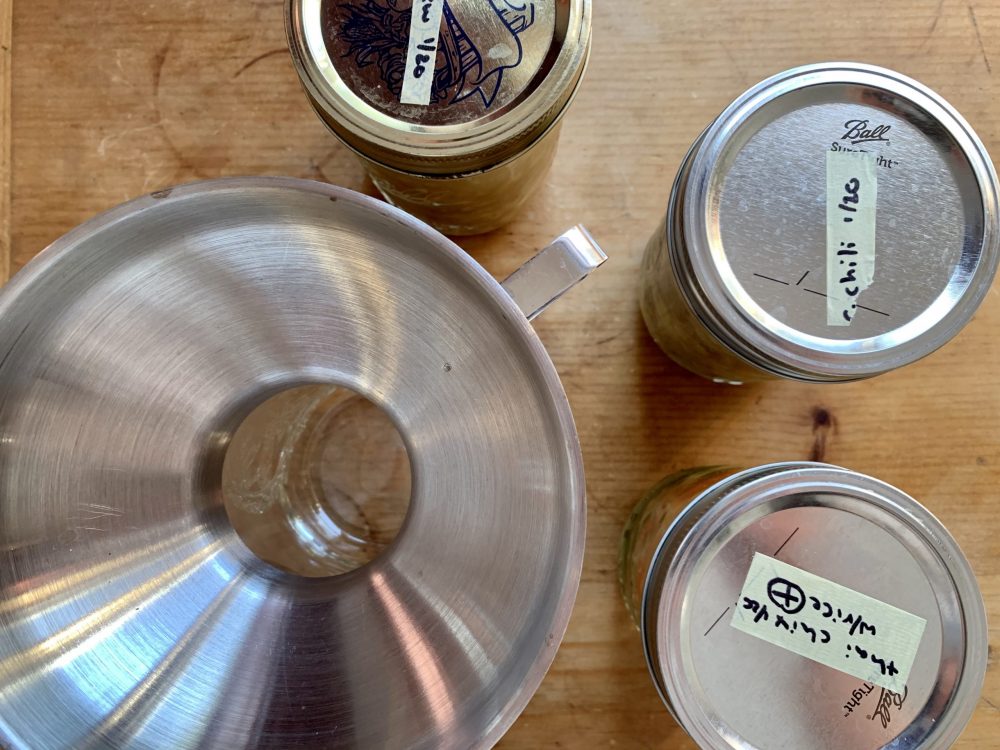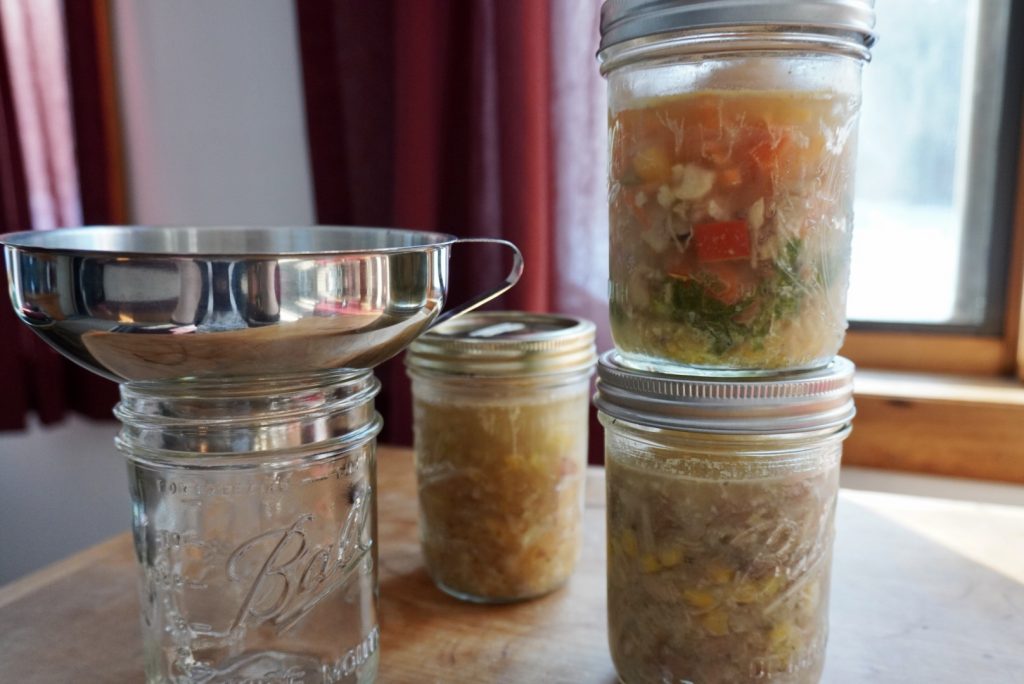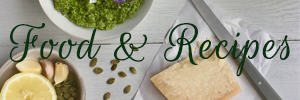Single-serving mason jars full of soup, broth, or stew are perfect for a quick lunch and when doing food prep when you’re single or have a small household. Pints of frozen broth are indispensable to grab quickly when I’m sick, making a recipe that calls for broth (yay for homemade bone broth with out any MSG and MSG-like additives!), or to sip when teaching to keep my throat from getting dry. Shannon works on the road and loves having a variety of soups, stews, and chili on hand to pull for lunches to help him resist the temptation of fast food – he heats them up in the morning and puts them in a thermos.
We started our single-serve freezer kick when Shannon went out of state to living out of a hotel room for work. We batch-cooked three recipes in the InstantPot and sent him with a cooler full of a month’s supply of lunches and dinners. (It was cold enough that winter that he just left the cooler strapped to the back of his work truck and would pull a week’s worth of jars at a time for the hotel mini fridge.) It was so convenient that now we always have at least two or three types of soups in the freezer for an easy-grab meal. Sometimes we batch cook specifically for the freezer but more often we just make big batches when cooking dinner, then send the leftovers to freezer school.
1. Get the Right Kind of Jar
Not all mason jars are freezer safe. You’ll find a chart indicating which styles are freezer safe on your mason jar box and online. Basically, you need jars with straight edges, which are conveniently also stackable. My personal fave is the 16-ounce (pint) wide mouth jar, which is also the largest size freezer-safe jar commonly sold. (The biggest freezer-safe jar is the 24-ounce-er, but this size is hard to find.) As much as I love quart-size and half-gallon jars in the kitchen, they are not freezer safe, so you’re risking breakage by using them. The cute, squat, straight-sided 8-ounce (1 cup) wide mouth jar is handy for freezing pesto and dips, but this shape is really hard to find even on Amazon.

Freezer Safe Options
- 4 oz (1/2 cup) regular/small-mouth
- 8 oz (1 cup) regular/small-mouth
- 8 oz (1 cup) wide mouth straight sided jars (hard to find but super cute)
- 12 oz regular/small-mouth
- 16 oz (pint) wide mouth = my favorite! practical and easy to find in stores
- 24 oz wide mouth (hard to find, but my favorite for smoothies and drinks)
Where Do You Buy Mason Jars? You can find standard-size mason jars in most “mom and pop” local hardware and feed stores like Aubuchon and Agway. Target usually has a small selection, and well-stocked grocery stores might stock them during canning season. Here in New Hampshire, Goffstown Ace Hardware has the best selection of mason jar sizes and accessories (including the 24-ounce jar). And of course you can find almost anything on Amazon. Beyond freezing soups, mason jars are fabulous for storing herbs dry goods, leftovers, etc. If you have a local food store with a bulk section that allows you to fill your own jars (like the Concord Food Co-op), wide-mouth jars work better than regular/narrow-mouth jars.
2. Fill It Right
You need to leave ample head space in the jar to allow for liquid expansion and avoid breakage. Note the freezer line. This expansion issue is also why jars that are not .straight-sided (such as the ubiquitous quart jar) are not freezer safe; pushing against that curve will break the jar.

I adore my stainless steel jar funnel for easy filling with less mess, though of course it’s not essential.
3. Avoid Rapid Temperature Changes
Glass can’t handle quick changes with temperature extremes – it could crack or even explode. One friend suffered serious burns from pouring boiling water into a jar cold from a farmhouse pantry. Filling room temp jars with hot liquid is fine. But don’t put hot liquids into cold jars, nor should you take piping hot just-filled jars and pop them immediately in the freezer. Let them cool a tad on the counter, then chill in the fridge, and pop them in the freezer the next day.
4. Thawing and Heating Methods
I was resistant initially to use glass for freezing broth and soup because – unlike plastic deli containers – you can’t just run them under hot water for a sec to dislodge and plop in a pan. Because the sides aren’t perfectly smooth, it needs to be relatively melted to release from the jar. And running a frozen jar under hot water is asking for glass to break. Here are a couple alternate options:
- 1. The safest way to thaw frozen jars is to leave them in the fridge for a few days.
- 2. You can let it thaw on the counter for several hours, but you DO risk food safety issues.
- 3. At the hotel, Shannon thawed his in a bowl of warm-ish (not hot!) water. There is some risk of breakage, but we’ve been lucky.
- 4. I microwave mine straight out of the freezer (remove the metal lid, of course!) and have discovered that they (so far) survive the process without breakage, though there is certainly a risk. Check on it regularly to break up ice chunks and stir. Due to the nature of a microwave, it’s possible to have a frozen chunk with boiling water right next to it, which is a recipe for disaster in so many different ways. Partially thawed jars will microwave even more smoothly because it’s the ice suck to the edge of the jar that melts last in the microwave but first when thawing on the counter or in the fridge.
- If you’re a no-microwave person, you can use method 1, 2, or 3 and then pop it in the pan as soon as it thaws well enough to dislodge from the jar.
5. Label It
Don’t forget to mark what it is and ideally the date… you might forget otherwise! Sharpie on masking tape works fabulously – holds well yet removes easily. Put the label on promptly. Tape won’t stick to cold or frozen jars. If you want an extra level of OCD-style organization, keep a chart of everything that’s in the freezer on a clipboard nearby and erase or cross off items as you remove them. If you’d like to keep a record of what went into each recipe (especially important for families with food reactions), this is also a good place to match your jar label to greater detail.
Freezer Friendly Dishes & Ingredients
- Broth of any type
- Chili made with meat and/or beans
- Beef stew
- Chicken stew (carrots, onions, celery) or chicken and rice soup
- Tomato-based soups, stews, chili
- Carbs: rice (non-white rice doesn’t get as mushy and is better for you), carrots, cauliflower rice, corn, peas, or root veggies (potatoes and pasta do ok) as a carb
- Veggies: celery, onions, garlic, and the aforementioned carrots, winter squash, pumpkin, peas, most roots (diced bell peppers, green beans, asparagus and grated zucchini do ok)
- Legumes
- Chicken, beef, and other meats in liquid recipes or shredded and stored in broth
- Winter squash and pumpkin, especially pureed. I often preserve the winter squash harvest this way, but you could also do pureed squash soups
- Definitely play around with different cultural influences such as Vietnamese pho (add fresh garnishes before serving), Indian curries, Moroccan stews, etc. Many of your InstantPot or slow cooker recipes freeze well.
- Soups aside, shredded cheese, applesauce, pesto, juice, milk (but not cream or half and half), oat milk, and jams all freeze well in mason jars, too.
What to Skip
Not everything freezes well. You’ll want to skip most leafy greens, fresh herbs, and other lighter consistency veggies unless you’re not a picky eater. For example, previously frozen eggplant or zucchini slices take on a slimy-spongy texture. Dairy, especially cream, tends to separate and get chunky. You can those items just before serving as a garnish. Coconut milk is probably ok but best added before serving, too.
Clinical herbalist Maria Noël Groves sees clients and teaches classes at Wintergreen Botanicals Herbal Clinic & Education Center in Allenstown, New Hampshire.
The statements made on this blog have not been evaluated by the FDA and are not intended to diagnose, prescribe, recommend, or offer medical advice. Please see your health care practitioner for help regarding choices and to avoid herb-drug interactions.








